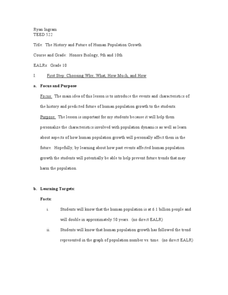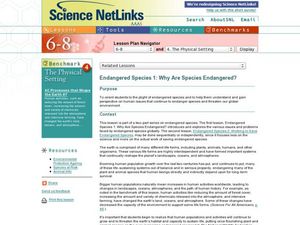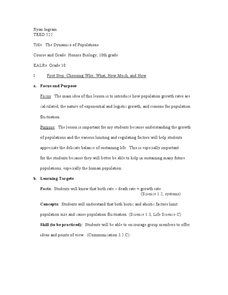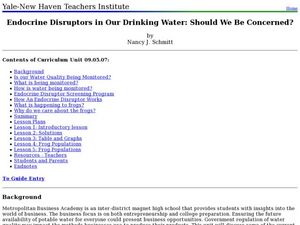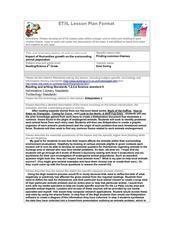Curated OER
Displaying Populations: Jellybeans, Paper and People
Young scholars investigate the factors affecting population growth. In this biology lesson, students collect data from the lab and graph them. They estimate population size using a mathematical formula.
Curated OER
Human Population Growth in the Future, What are We Going to Do?
Students predict what will happen to human population in the future. In this biology lesson plan, students brainstorm possible solutions to overpopulation problems. They create a persuasive brochure about their views on this issue.
Curated OER
Historic Population Chart
Students examine the changes in the population in Idaho over a specific amount of time. In groups, they use the digital atlas to identify the trends in the population and describe why and how they exist. To end the lesson, they compare...
Curated OER
The History and Future of Human Population Growth
Students create a timeline of human population growth based on guided reading. In this biology lesson, students analyze the trend of how population increased over time. They share their findings in class.
Curated OER
Environmental Limitations
Seventh graders study the environmental factors that affect population growth. In this biology lesson, 7th graders create a city following certain criteria. They present their posters in class.
Curated OER
Create a City: An Urban Planning Exercise
Students explore the effects of population growth in Arizona. In this history lesson plan, students work in small groups to create a "perfect" city. Activities include examining the Arizona census results then discussing the...
Curated OER
Population Pyramid
Students learn about demographic population pyramids. They then design and fictitious nation and draw its population pyramid.
Curated OER
Endangered Species 1: Why are Species Endangered?
Emerging ecologists examine endangered species by visiting the US Environmental Protection Agency website. They consider human contribution to the decline of different species. They research an endangered animal and then craft a poster...
Curated OER
The Impacts of Human Activities on Biodiversity in New Haven County
Students discover how plants and animal ecosystems are affected by the growth of a city. In this ecology lesson, students study and observe a plant over a period of time. They develop a creative presentation of their data and share them...
Curated OER
The Dynamics of Populations
Tenth graders analyze the growth rate of different population. For this biology experiment, 10th graders identify the biotic and abiotic factors that limit population size. They create a poster to show their findings in class.
Curated OER
Modeling Natural Disaster with Mathematical Functions
Ninth graders investigate the functional relationship of different environmental phenomena. In this math lesson, 9th graders create models of various natural disasters. They use logarithmic and exponential functions to interpret...
Curated OER
Problem Based Learning Scenario
Students research about the function of MPA's. For this marine science lesson, students explore how humans influence changes near these areas. They explore different MPA's in the Great Lakes region.
Curated OER
Endocrine Disruptors in Our Drinking Water: Should We Be Concerned?
Students investigate the different hormone contaminants in the water supply. In this math instructional activity, students analyze data tables and graphs. They demonstrate exponential growth and decay using frog populations.
Curated OER
A Sense of West Virginia
Students consider their perceptions of the world through their 5 senses while visiting the West Virginia State Museum. In this West Virginia history lesson, students discover how knowing about the past helps with their understanding of...
Curated OER
Impace of Humanities growth on the Surrounding Animal Population
Fourth graders read books about endangered animals. Using Kidspiration software, 4th graders create a presentation illustrating the plight of endangered animals. They identify problems, develop a graphic organizer, and explain the origin...
Curated OER
Postcards from California: A Unit on Geography, Social Studies, History and California's Resources
Fourth graders examine patterns that influence population density in the various regions of California. The unit's three lessons utilize graphic organizers for the interpretation and presentation of data.
Curated OER
Canada's Natural Regions and Their Varied Characteristics
High schoolers study Canada's six natural regions, including both the human and economic activities of each. In groups, they create a display representing one of the six regions.
Curated OER
Haniwa
Students use non-fired clay and posterboards to create and display examples of Haniwa and kofun in this exciting lesson for the Social Studies, Humanities, Asian Studies, or Art classroom.
Curated OER
Designing a Real Life Ecosystem!
Students research abiotic and biotic factors concerning the concept of an ecosystem. Record and analyze data collected. Write a lab report in proper and scientific format with thinking and analytical skills. Work as a cooperative team.
Curated OER
Endangered Species !: Why Are Species Endangered?
Students explore the various issues and problems faced by endangered species globally. They research the plight of endangered species, create a poster of a selected animal, and present their poster and research to the class.
Curated OER
Marine Protected Areas (MPA)
Ninth graders explain the purpose of MPA's. In this biology lesson, 9th graders identify MPA's in Southern California. They simulate coastal sampling using candy from two buckets. Students analyze their results and share it with the class.
Curated OER
Monitoring an Epidemic: Analyzing Through Graphical Displays Factors Relating to the Spread of HIV/AIDS
Tenth graders differentiate pandemic and epidemic. In this health science lesson, 10th graders analyze how HIV and AIDS affect different countries. They construct and interpret different types of graphs.
Curated OER
Creating an Online Disease Pamphlet Using Online and Print Resources
Eight grade health learners choose a disease to research. They compose their information and create a brochure to give to people who are affected by their chose disease. They address the history, causes, symptoms, diagnosis, and...



